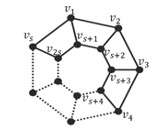The spectrum on prism graph using circulant matrix
DOI:
https://doi.org/10.12928/bamme.v2i1.5129Keywords:
Circulant matrix, Eigen value, Eigen vector, Regular graph, Spectral graph theory, Spectrum of a graphAbstract
Spectral graph theory discusses about the algebraic properties of graphs based on the spectrum of a graph. This article investigated the spectrum of prism graph. The method used in this research is the circulant matrix. The results showed that prism graph P2,s is a regular graph of degree 3, for s odd and s ≥ 3, P2,s is a circulantt graph with regular spectrum.
References
Anton, H. (2005). Elementary Linear Algebra, 9th ed. Hoboken: John Wiley & Sons.
Baca, M., Bashir, F., & Semanicova, A. (2011). Face Antimagic Labelings of Antiprisms. Util Math 84, 209-224.
Biggs, N. (1993). Algebraic Graph Theory, Second edition. Boca Raton: Chapman & Hall/CRC.
Chartrand, G., & Lesniak, L. (1996). Graphs & Digraphs, Third Edition. Boca Raton: Chapman & Hall/CRC.
Cvetkovic, D., & Gutman, I. (2009). Applications of Graph Spectra. Belgrade and Kragujevac.
Gutman, I., Vidović, D., & Stevanović, D. P. (2002). Chemical applications of the Laplacian spectrum. VI On the largest Laplacian eigenvalue of alkanes. Journal of the Serbian Chemical Society, 67(6), 407-413.
Hasmawati. (2008). Spektrum Graph Lengkap dan Siklus. Jurnal Ilmiah Elektrikal Enjiniring UNHAS, 6(3).
Kolman, B. (2004). Elementary Linear Algebra 8th ed. New Jersey: Pearson Education.
Kristiana, R. W. (2010). Spektrum Graf Mobius Ladder. Thesis. Semarang: Universitas Negeri Semarang.
Maas, C. (1985). Computing and Interpreting the Adjacency Spectrum of Traffic Networks. Journal of Computational and Applied Mathematics, 459-466.

Downloads
Published
Issue
Section
License
Copyright (c) 2022 Triyani, Mashuri, Bunga Tirai Anarkis, Slamet Riyadi

This work is licensed under a Creative Commons Attribution-ShareAlike 4.0 International License.
Authors who publish with this journal agree to the following terms:
- Authors retain copyright and grant the journal right of first publication with the work simultaneously licensed under Creative Commons Attribution License that allows others to share the work with an acknowledgement of the work's authorship and initial publication in this journal.
- Authors are able to enter into separate, additional contractual arrangements for the non-exclusive distribution of the journal's published version of the work (e.g., post it to an institutional repository or publish it in a book), with an acknowledgement of its initial publication in this journal.
- Authors are permitted and encouraged to post their work online (e.g., in institutional repositories or on their website) prior to and during the submission process, as it can lead to productive exchanges, as well as earlier and greater citation of published work (See The Effect of Open Access).



